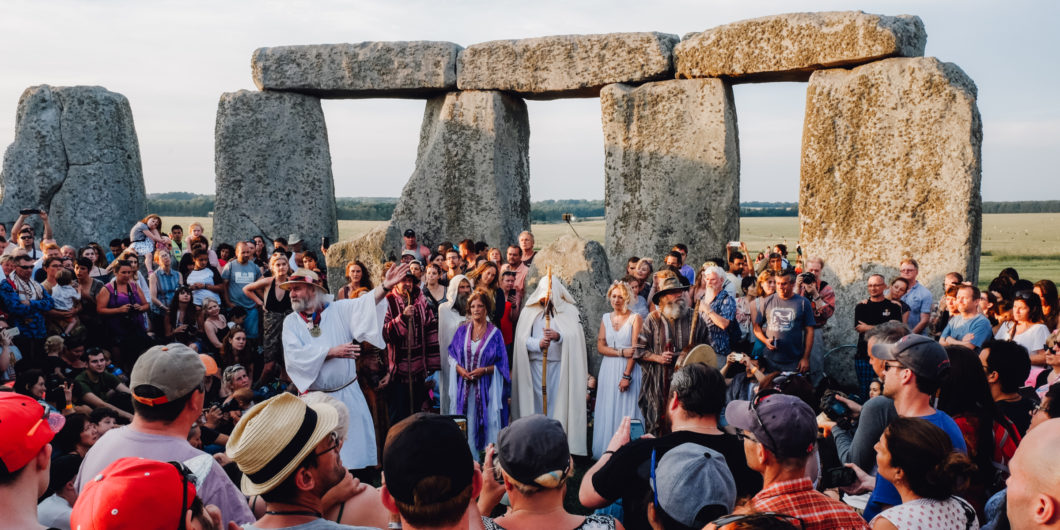The common claim that just seventeen percent of the founding generation was “churched” is founded on bad social science.
Pursuing Meaning
The United States has always been a godly nation. At the Founding of our Republic, we celebrated the inalienable rights granted to us by God. Some of our first settlers are referred to as “the pilgrims,” and many more immigrants followed their lead by seeking religious freedom on these shores. The whole history of our nation is marked with religiously motivated moral crusades and Great Awakenings; it is not for nothing that Abraham Lincoln referred to us as an “almost chosen people.” Here in the 21st century, we are still in our way a very spiritual people. However, we no longer clearly see ourselves as one nation under God. Today, we are one nation under many gods.
This new reality is explained in some detail in Tara Isabella Burton’s new book Strange Rites: New Religions for a Godless World. It’s a must-read for anyone who wishes to understand the new paganism that has penetrated our elite culture. From Harry Potter to wellness culture to the rebirth of Wicca, Burton knows her pagans. By the end of the book, readers feel oriented to the different strains of anti-traditionalism that are vying for influence over the American mainstream.
As we might expect, many colorful characters emerge from the pages of Strange Rites. We meet women who regard themselves as the spiritual wives of Severus Snape. We encounter people who have spent $17,000 on tickets to an interactive Broadway production of MacBeth. Free-love communes and black-pill anarchists all make their appearance. It’s tempting to dismiss this as a book about new-age whack-jobs, but part of the point is that new-age nuttiness is the new normal. Burton’s anecdotes aren’t primarily drawn from the hills of Appalachia, or from survivalist homesteads in the Arctic circle. She’s describing the behavior of Manhattanites, Bostonians, and Hollywood divas. These weirdos are running our nation now.
Consuming Religion
In some ways, perhaps, the trends she describes may not represent such a radical change. America has always fostered a great deal of spiritual experimentation. We’ve had Quakers, Shakers, and prosperity preachers. Hippies and quietists periodically drift off the grid, returning to nature or God or gods. The Age of Aquarius dawned some time ago, but the sun has not yet set on the land of the free. How novel is DIY spirituality in this American life? Hasn’t the pagan beast been slouching towards Bethlehem for quite some time already?
It has, and Burton acknowledges as much through periodic forays into our nation’s religious history. Americans have always set great stock on authentic religious experience, and this priority has often pressed institutional religion to the margins. From Emerson and Thoreau to Oprah Winfrey, Americans have long preferred to make their own spiritual rules. Nevertheless, Burton argues that the modern situation is different. For one thing, the internet has transformed our spiritual landscape, as it has so many other things. In the virtual age, it is possible to worship, fetishize, venerate, or hex practically anything, in company with the fifty other people on this planet who wish to do the same thing. Our desire for community once gave us an incentive to curb our weirder behaviors, but we’re now free to be as outlandish and flaky as we like.
Many of us do like this, in part because we’re lonely. As marriage, family, and the traditional village have eroded, younger generations have gone searching for new forms of spiritual community. They want shared spiritual experiences, but, as children of a prosperous age, they approach religion just as they approach everything else: as consumers. They expect to pay for their spirituality, and they expect it to meet their “spiritual needs.” For these would-be worshippers, it seems perfectly reasonable to spend thousands of dollars on spiritual “kit,” and there’s nothing strange about splicing together a children’s book, an exercise regimen, a juice cleanse, and some whale songs, and calling that a religion.
Deeper Fads?
“Intuitional religion,” as Burton calls it, has many faces. Internet fandom has created a huge array of eclectic tribes: World of Warcraft geeks, Comic-Con fanatics, self-described “Jedis.” SoulCycle outlets offer magical shoes and water, along with feel-good mantras designed to inspire patrons to realize their best selves. Meanwhile, in the covens of our new modern witches, feminist empowerment meets social activism for a nice, sage-scented brunch. All of these movements are explored in detail in Strange Rites. For good measure, Burton also walks us through the lingo and lore of the atavist right. This will seem jarring to some, but she rightly recognizes that the rage-driven lordlings of the dark web and manosphere are in many ways the mirror image of their pagan counterparts on the political left. They are obsessed with self-definition, and they build quasi-religious rituals and identities out of a million disparate parts, like geeks creating characters in Dungeons and Dragons.
To a faithful, Mass-attending, Magisterium-heeding, contraceptive-shunning Roman Catholic like myself, Burton’s book is both fascinating and eye-opening. It inspires reflections on whether I myself may have been walking past the graveyard for several years, cheerfully assuming that quinoa salads and agave-nectar facial masks could be written off as nothing more than snacks or beauty products. As denizens of a modern consumer culture, we are all thoroughly habituated to “new and improved” everything, and to flaky spirituality-speak. When a bottle of kombucha promises to “amp up my positive energy,” it probably doesn’t occur to me that anyone really believes there’s some vibey voodoo at work when I sip my Gingerade. While reading Burton’s book, I found myself wondering whether the new paganism may have advanced much further than I’d appreciated, simply by camouflaging itself as normal product promotion. I notice and object when men started to show up in my locker room, or when Satanists pressure small business owners to bake them demonic cakes. Other intuitional “sects” may wash over me unnoticed though, because they just look like silly fads.
Will the flashes of neo-pagan spirituality be revealed as incapable of speaking to real human suffering?
Are they really more than that, though? This is the question I found myself pondering as I read Strange Rites. If paganism has conquered America by stealth, that could be quite bad. There is still a glass-half-full way to see this though: maybe our new-age progressives have sold their Judeo-Christian heritage for a mess of quinoa pottage. If the “strange rites” of the new paganism are really this half-baked, traditionalists may be in quite a strong position moving forward. Progressives do seem to have the edge in many of our institutions, but how much do they really have to offer? Historical precedent suggests that DIY spiritual movements are often transient, mainly because they are too faddish to survive for long. Customized, consumer-driven religion can be pleasant for a time, but this creates a spiritual world in which (in a best-case scenario) you get what you pay for and no more. What happens when that isn’t enough? Transcendent faiths can have deep roots that enable them to adapt and renew themselves from within, meeting changing spiritual needs and supplying answers to the questions that are asked in each successive age. It’s not clear that the new paganism can do that, and if it cannot, it will age poorly. My family worships in a parish that has existed since 1887, dedicated to a Roman girl who was martyred in the year 304. A century or sixteen from now, will anyone still remember SoulCycle’s magic water? Will people still care about Jedis?
The Spiritually Hungry Unite
In the short-term, Burton is clearly right that non-Christian rituals have become more prevalent in our nation, and it also seems true as well that the affluent young are approaching religion quite differently from their forbears. They come to the altar as customers, not as penitents. In America today, it seems, the addicts and prostitutes love Jesus, while the educated prefer Hectate. It seems true, as well, that the internet has acted as a kind of hot wind behind the new paganism, blowing the embers of American intuitionism into a roaring conflagration. There are obviously close connections between the new paganism and contemporary political developments that religious conservatives lament: the aggressive promotion of new sexual “identities,” the furious hostility towards Judeo-Christian religion, and the advance of an ever-more-demanding political correctness. Clearly, these new sects are quite willing to challenge Christianity for cultural dominance. This is troubling.
We should be grateful to Burton for walking us through the primary sects of the new paganism. A Catholic convert herself, Burton is nevertheless familiar with the altars of the modern pagan world, and she explains them in language that traditionalists can understand. It’s a freaky tour, with some weird and disturbing exhibits.
By the end of the book, though, this reader was feeling a surprising sense of calm. I have, in the past, been discomfited by pagan practices that popped up unexpectedly, as when I awoke one morning last winter to witness the last of my neighbor’s “solstice party” on her back lawn. (Her guests were performing a kind of a ritual dance, evidently in homage to the rising sun. It felt sinister. What else do I not know about my neighbors?) Surveying the pagan plain from ten thousand feet though, it’s easier to laugh. In fact, I found it impossible not to laugh at many points throughout the book. The trends Burton described were just so unspeakably silly. Do progressive liberals really think they can face off against the Abrahamic faiths armed with this? St. Michael would make mincemeat of these guys.
Maybe that’s too complacent. Then again, maybe not. Looking past the freaky idiosyncrasies of these various new sects, we can discern another common thread, which joins the witches and Proud Boys and chia-seed eaters. All of these folk are desperately hungry for meaning. Modernity’s rations have been meager, and like spiritual scavengers, the new pagans are gobbling whatever scraps they can find, on television or social media, or in politics. They’re still spiritually undernourished. They need more.
Traditionalists tend to be quite confident that we have more. Our magisteria and ancient rites connect us to true, living water, of a sort that SoulCycle will never be able to bottle. If this is really true, we need to find ways to offer it to our thirsty pagan brethren. This is a daunting task, most especially because they are unused to assuming the posture of penitents. If you’re used to buying everything your heart desires, it can be difficult to understand a treasure offered on rather different terms. In light of the present crisis, though, it seems likely that difficult days lie ahead. Will the flashes of neo-pagan spirituality be revealed as incapable of speaking to real human suffering? As an almost-chosen nation, Americans like to approach new challenges with a sunny confidence that we can overcome. The strange rites of Burton’s book are bizarre and often foolish, but they are still recognizably American in many profound ways. Intuitional religion is part of our nation’s heritage, and the shallowness of the new pagans does reflect in many ways that same entrepreneurial restlessness that has in other contexts been a strength. Conservatives should read it and consider our options. We know that we have a hard road ahead, but it is still possible that America will again be united someday as one nation, under God.



